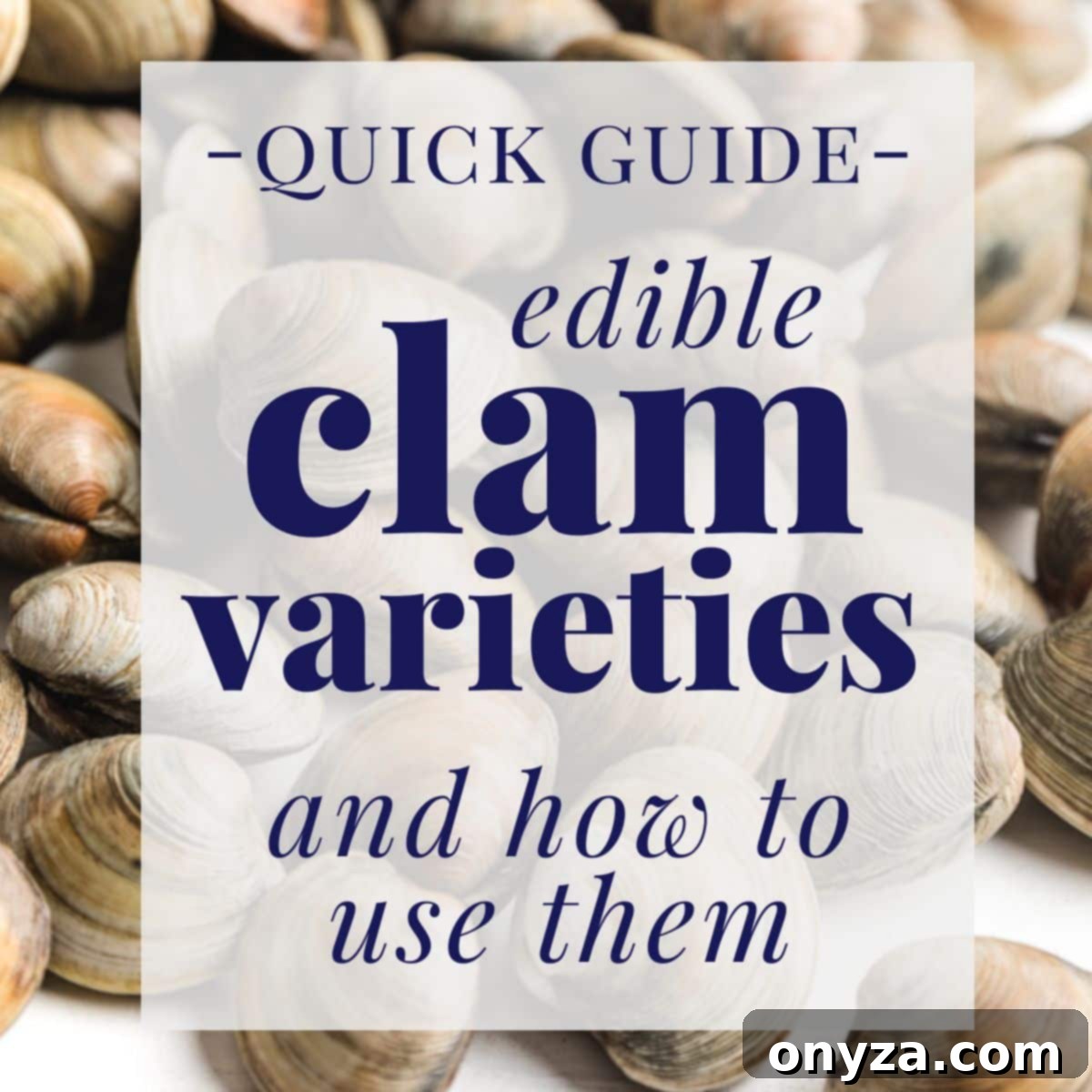Are you eager to navigate the diverse world of edible clams, whether at your local seafood market or during a coastal foraging adventure? This comprehensive guide will illuminate the most popular clam varieties, offering insights into their unique characteristics and the best culinary approaches to savor their distinct flavors. Discover how to identify, prepare, and enjoy these versatile bivalve mollusks to elevate your home cooking.

The Basics: Exactly What Are Clams?
Clams are fascinating marine creatures belonging to the bivalve mollusk family, much like their cousins, mussels and oysters. The term “bivalve” perfectly describes them: they possess two hinged shells that protect their soft bodies. While clams thrive in both fresh and saltwater environments across the globe, the varieties cherished for culinary purposes are predominantly saltwater species, found burrowed beneath the sands and muds of ocean floors.
A key differentiator for clams, compared to mussels and oysters that attach themselves to rocks or other submerged structures, is their preference for burying themselves. Using a muscular “foot,” clams dig into the sediment, creating a secure home. The depth at which they burrow varies significantly among species, influencing their shell characteristics and how they are harvested.
Beyond their culinary appeal, clams play a vital role in marine ecosystems as filter feeders. They draw in water, extract microscopic organisms for sustenance, and expel cleaner water, contributing to the health of coastal waters. Nutritionally, clams are a powerhouse, offering lean protein, essential amino acids, and a rich source of minerals like iron, zinc, selenium, and B vitamins, making them a healthy addition to any diet.
Why Explore Different Clam Varieties?
With thousands of clam species existing worldwide, it might seem daunting to distinguish between them. However, understanding the nuances of the most common edible varieties can profoundly enhance your cooking. Each type of clam offers a unique profile in terms of flavor, texture, and ideal cooking methods. From the delicate brininess of a raw littleneck to the robust chewiness of a chowder clam, choosing the right variety ensures your dish reaches its full potential. This guide aims to empower you to select clams with confidence, whether you’re planning a sophisticated seafood pasta or a casual beachside steam.
Popular Types of Clams for Cooking
While the ocean teems with diverse clam life, only a select number are commonly found in seafood markets and featured in gourmet recipes. Let’s delve into the most beloved and versatile types of clams perfect for your kitchen.
1. Hard Shell Clams (“Quahogs”)
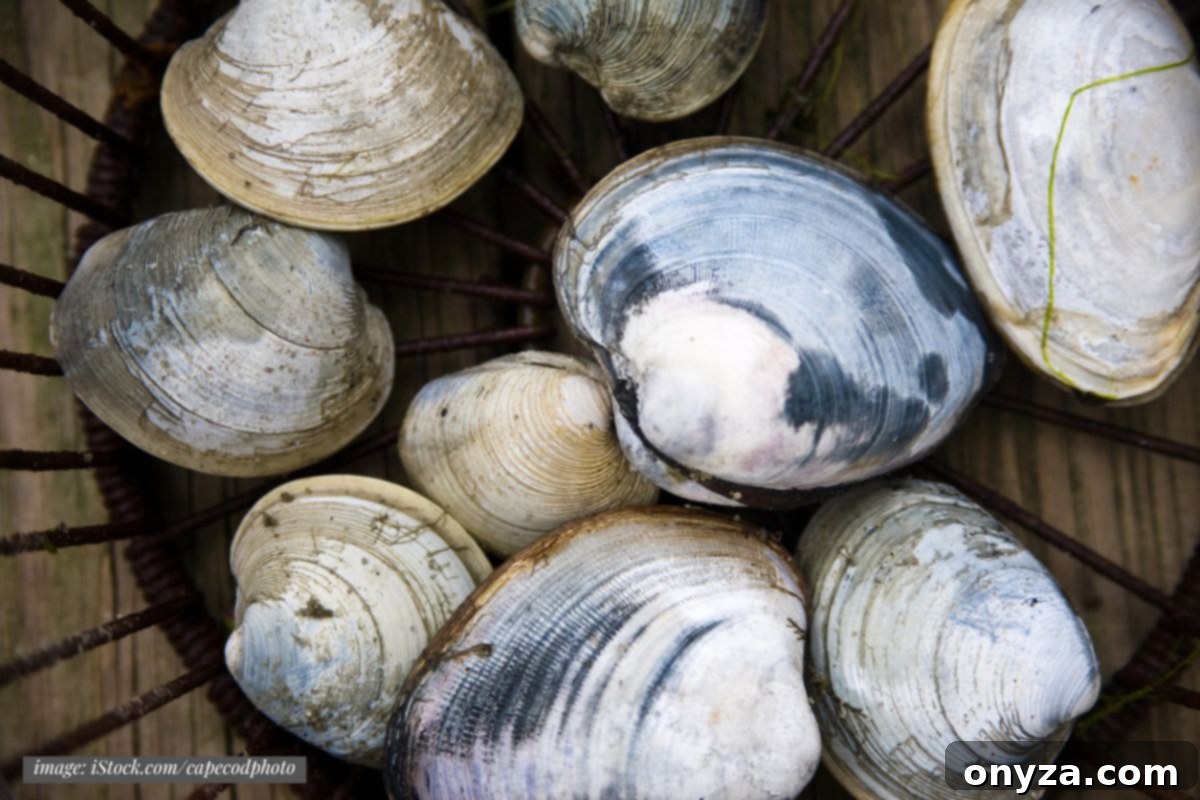
Hard shell clams, often referred to collectively as “Quahogs” (pronounced KO-hogs, with regional variations), are perhaps the most ubiquitous type of clam available. These robust clams are characterized by their thick, hard, and typically oval-shaped shells. They are native to the Eastern Seaboard of North America, stretching from Canada down to Florida, and are particularly celebrated in regions like Rhode Island.
Quahogs encompass a range of sizes and ages, each with its own culinary designation:
- Littlenecks: These are the smallest and youngest of the quahog family, typically 1 to 2 inches in diameter. Their tender, sweet meat and delicate texture make them highly prized for raw consumption on the half-shell or for quick cooking methods like steaming and pasta dishes.
- Topnecks: Slightly larger than littlenecks, usually between 2 and 3 inches, topnecks offer a bit more substance while retaining good tenderness. They are excellent for steaming, grilling, and adding to clam sauces.
- Cherrystones: Ranging from 3 to 4 inches, cherrystones have a firmer texture and a more pronounced clam flavor. They are ideal for stuffing, grilling, or incorporating into heartier soups and stews.
- Chowder Clams: The largest and oldest quahogs, often exceeding 4 inches in diameter. Their meat is the toughest and most flavorful, making them perfectly suited for chowders and other preparations where the clams are chopped or minced. The name itself is a testament to their primary culinary application.
Hard shell clams, particularly littlenecks, are extensively farmed, ensuring a consistent and sustainable supply at grocery stores and seafood counters. Fresh quahogs are identifiable by their tightly closed shells, which exhibit a beautiful array of variegated colors ranging from white and cream to brown and gray, often with darker concentric rings.
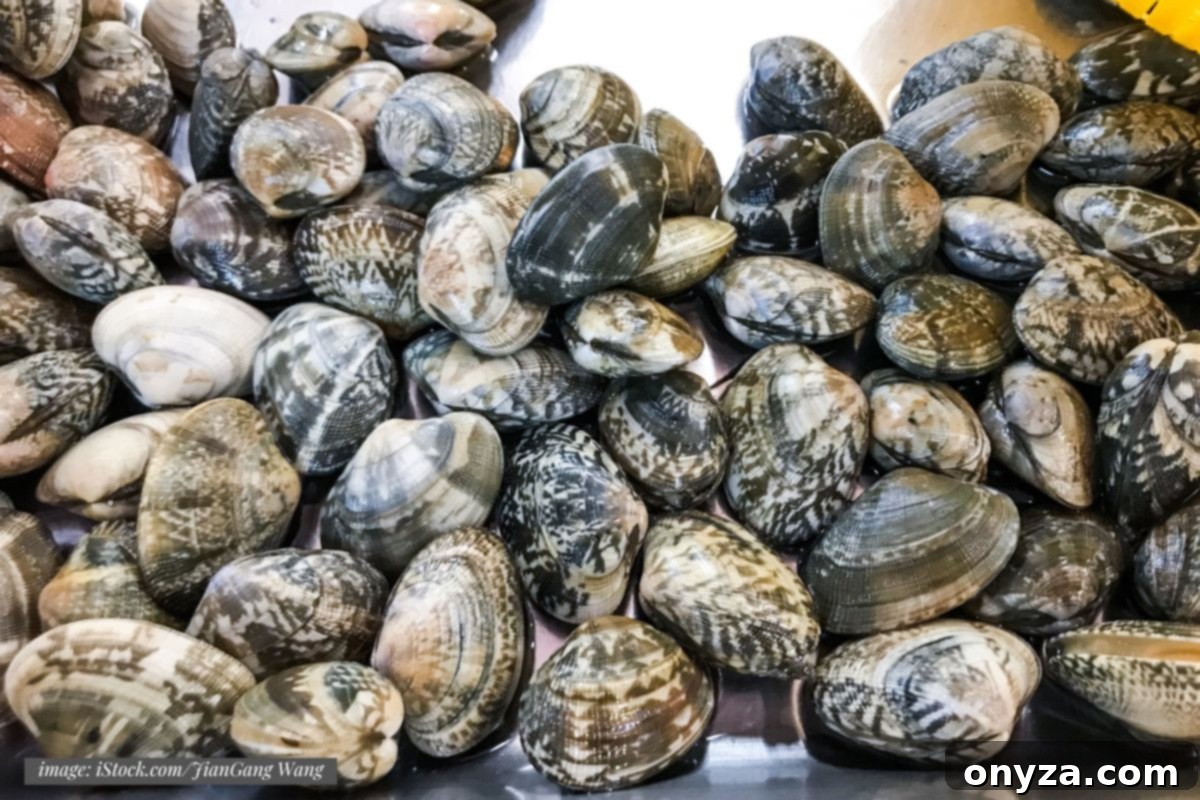
Another popular hard shell variety is the Manila clam. Though also a hard shell, their shells are notably thinner and more delicate than quahogs. Native to the Pacific Ocean, Manila clams made their way to the North American west coast around the 1920s via oyster shipments from Japan. Similar in shape and size to littlenecks, Manilas are often praised for being meatier and having a sweet, clean flavor. Their thinner shells contribute to a significantly shorter cooking time, making them a fantastic choice for quick preparation.
How to Use Hard Shell Clams: Hard shell clams are incredibly versatile. Littlenecks and Topnecks excel when steamed (try my Beer Steamed Clams for a delicious experience), grilled, or incorporated into pasta dishes such as the classic Linguine Alle Vongole. Their delicate flavor also makes littlenecks and small cherrystones perfect for eating raw on the half-shell, served simply with a squeeze of lemon or a mignonette. Cherrystones are ideal for stuffing, creating delightful dishes like Clams Casino, or for heartier grilling. For robust flavors, Chowder Clams are exclusively destined for their namesake, providing deep, rich clam essence to chowders and stews. Manila clams, with their quick cooking time and sweet flavor, are superb steamed, in stir-fries, or in any dish where you want a tender clam bite.
2. Soft Shell Clams (“Steamers”)
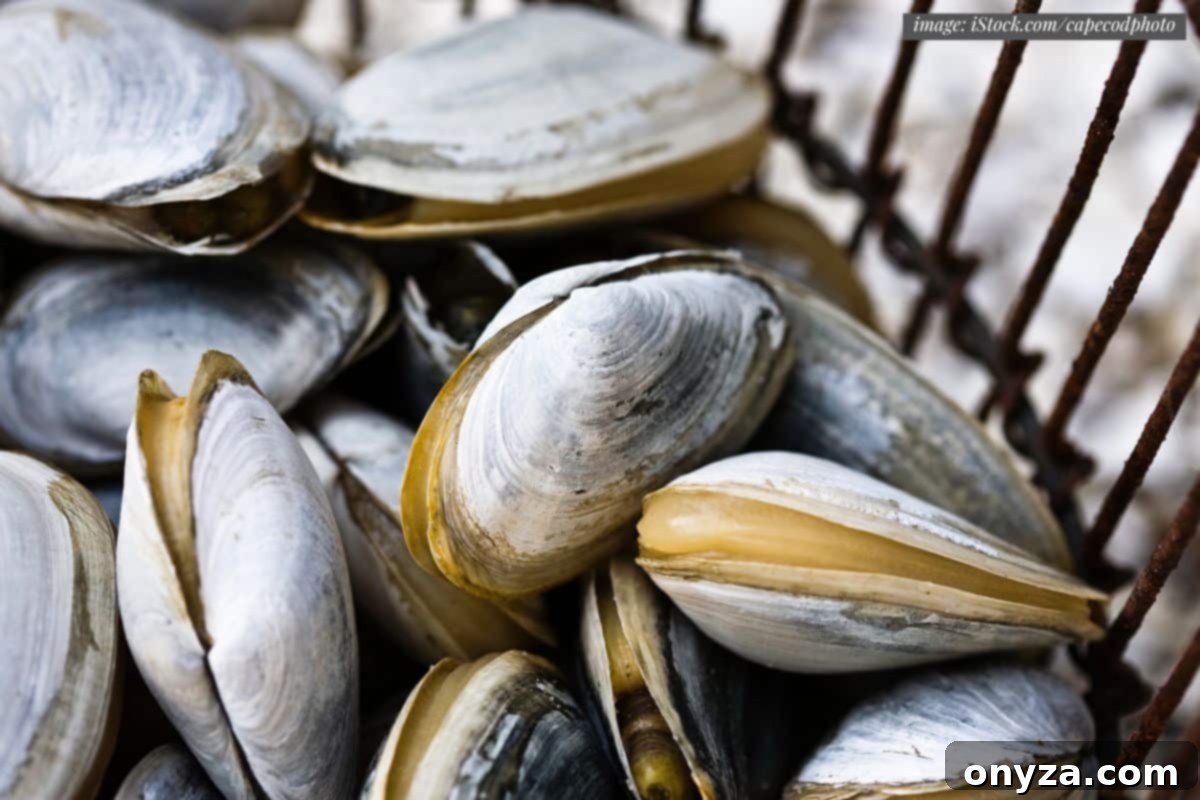
Soft shell clams, affectionately known as “Steamers,” “Ipswich clams,” or “longnecks,” are a beloved delicacy, particularly in New England. Unlike their hard shell counterparts, soft shells are characterized by their thin, brittle, and somewhat chalky-looking shells, which are typically shades of white and gray. These clams bury themselves much deeper in the sediment, sometimes up to a foot or more, necessitating a long, prominent siphon that extends to the surface to filter feed.
This extended siphon is a defining feature of soft shell clams, but it also prevents their shells from closing completely. This natural opening means they are more prone to retaining grit and sand, making thorough de-gritting an essential step before cooking. For detailed instructions on how to properly clean these clams, please refer to my comprehensive Fresh Clams Guide, linked at the bottom of this post.
Soft shell clams are predominantly harvested wild, adding to their allure and connection to regional culinary traditions. Their meat is exceptionally tender and boasts a sweet, distinct “clammy” flavor. When cooked, the siphon, while edible, often has a tougher texture and is sometimes peeled before eating. The shells themselves, being very thin and brittle, are not consumed.
How to Use Soft Shell Clams: As their popular nickname suggests, soft shell clams are most famously served steamed. A classic New England “steamer” meal involves cooking them gently in a flavorful broth (often beer or white wine with garlic and herbs) until they open. They are typically served with small cups of the strained clam broth for dipping and melted butter. Another quintessential preparation is fried clams, where the tender clam bellies are lightly breaded and deep-fried to a golden crisp, a true taste of summer from coastal clam shacks.
3. Razor Clams: Atlantic Jackknife and Pacific Razors
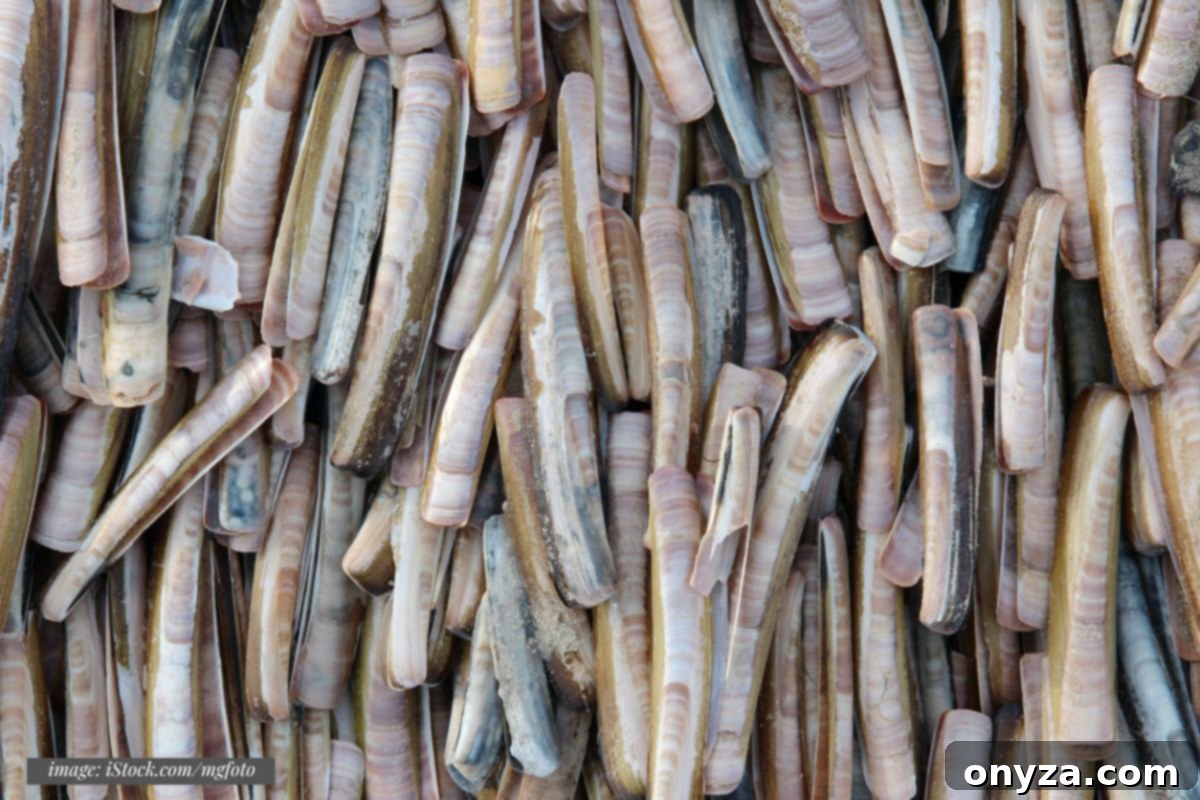
Razor clams stand out visually with their distinct elongated, rectangular shells that strongly resemble an old-fashioned straight-edged razor. These highly prized clams are known for their incredibly tender meat and unique flavor profiles, which vary significantly between the Atlantic and Pacific species.
Atlantic Razor Clams, often called “Jackknife Clams,” are found along the Eastern seaboard. They are relatively slender and possess a delicate, sweet flavor with a subtle brininess. Their elegant taste makes them a favorite among chefs and home cooks who appreciate nuanced seafood.
It’s crucial not to confuse them with their Pacific counterparts, as Pacific Razor Clams are an entirely different species with distinct characteristics. Found predominantly along the Pacific Northwest coast, these clams are wider, meatier, and possess a more robust, “clammier” flavor than the Atlantic variety. Pacific Razor Clams are also highly popular for recreational clam digging, providing a thrilling outdoor experience along the beaches of Washington and Oregon.
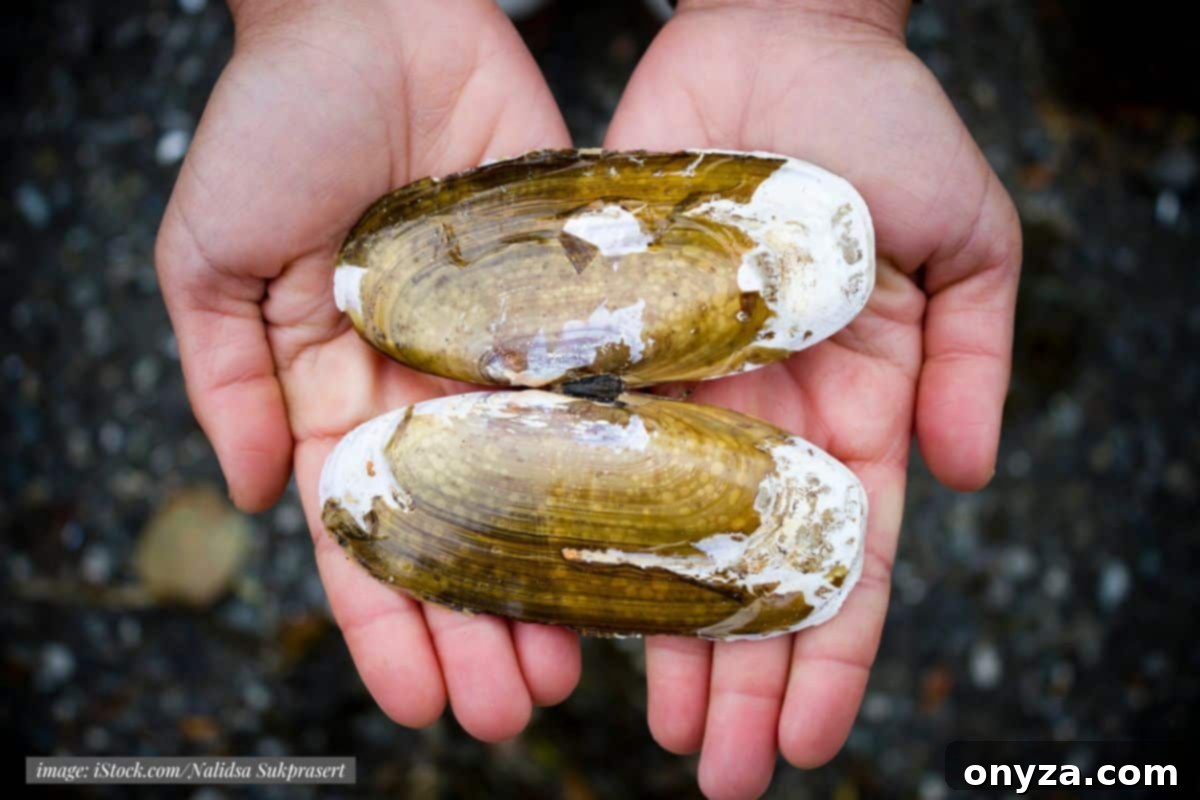
How to Use Razor Clams: Atlantic Jackknife Clams, with their delicate flavor, are best prepared in ways that highlight their sweetness without overpowering them. They are excellent steamed, grilled, or sautéed with light sauces featuring ingredients like garlic, shallots, fresh herbs, or a touch of white wine. They also pair wonderfully with Asian-inspired flavors, such as ginger and soy. Pacific Razor Clams, with their meatier texture and stronger flavor, are incredibly versatile. They are fantastic fried (often beer-battered), grilled, steamed, sautéed, and make a superb addition to ceviche or rich chowders. Their robust taste allows them to stand up to bolder seasoning and cooking methods.
General Tips for Buying and Handling Clams
Regardless of the variety you choose, ensuring freshness is paramount for a safe and delicious clam experience. When purchasing clams, always look for live specimens. Their shells should be tightly closed or, if slightly ajar, they should snap shut immediately when tapped. Discard any clams that remain open or have cracked or broken shells. A fresh clam should smell clean and briny, reminiscent of the ocean, not fishy or sulfuric.
Once home, store live clams in the refrigerator in an open container (like a bowl covered with a damp cloth) to allow them to breathe. Avoid sealing them in airtight bags or submerging them in fresh water, as this will suffocate them. Clams generally keep well for 2-3 days, but it’s always best to cook them as soon as possible.
Cleaning clams is another crucial step. While most farmed hard shell clams are relatively clean, wild-caught varieties and soft shell clams will benefit significantly from a purging process to remove sand and grit. This typically involves soaking them in a mixture of cool, salted water (mimicking their natural habitat) for 20-30 minutes, or longer for very sandy clams. For comprehensive, step-by-step instructions on cleaning and storing fresh clams, be sure to consult my dedicated Fresh Clams Guide. It includes a printable “how-to” to make your preparation foolproof!
Sustainable Clam Choices
As conscious consumers, making sustainable seafood choices is increasingly important. Many hard shell clam varieties, particularly littlenecks, are extensively farmed in managed aquaculture operations. These farmed clams are generally considered a sustainable choice, as they have minimal environmental impact and contribute to local economies. Wild-caught clams, especially soft shells and razor clams, are often subject to strict quotas and management practices to ensure healthy populations. To make the most informed decisions, you can consult regional seafood sustainability guides, such as those provided by the Monterey Bay Aquarium Seafood Watch program, which offer specific recommendations based on species and harvest location.
Conclusion: Dive Into the World of Clams
From the tender littleneck to the robust chowder clam, and the unique razor clam, the world of edible clams offers an exciting array of textures and flavors. Understanding the differences between these popular varieties empowers you to make confident choices at the seafood counter and elevate your culinary creations. Whether you prefer them raw, steamed, grilled, or nestled in a hearty chowder, clams are a nutritious and delightful addition to any meal.
Now that you’re equipped with the knowledge of various clam types and their best uses, are you ready to dive into the wonderful world of clams? Explore these incredible bivalves and bring the taste of the ocean to your table!
